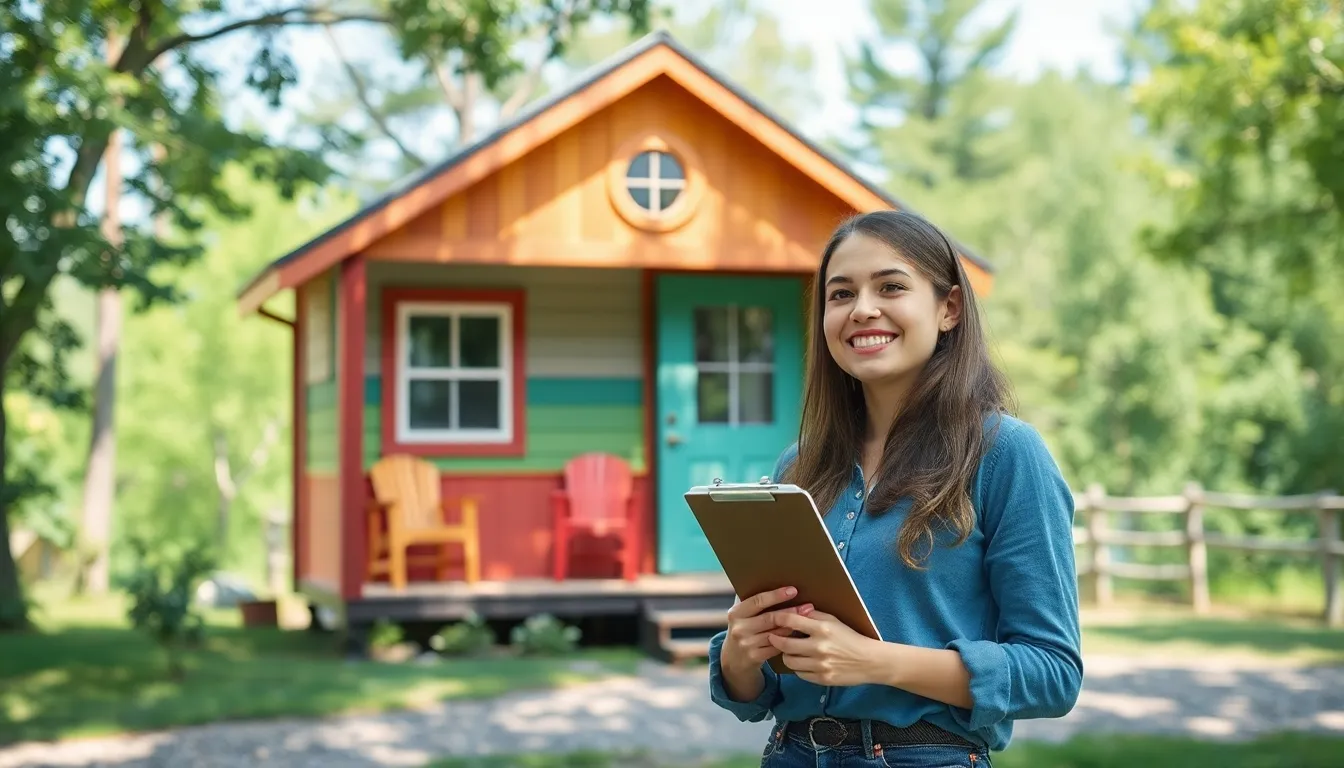Table of Contents
ToggleTiny houses have taken the world by storm, offering a charming alternative to traditional living. But before anyone gets too cozy in their pint-sized paradise, they need to navigate the labyrinth of tiny house legality. It’s like trying to fit a full-size sofa into a shoebox—challenging but not impossible!
Understanding zoning laws, building codes, and permits can feel like deciphering a secret language. One wrong move and that adorable tiny home could turn into a legal nightmare. So, whether someone dreams of a minimalist lifestyle or simply wants to escape the rat race, knowing the legal landscape is crucial. Buckle up as we dive into the fascinating (and sometimes hilarious) world of tiny house regulations. Who knew tiny living could come with such big legal headaches?
Overview Of Tiny House Legality
Tiny house legality involves navigating various regulations that differ across locations. Zoning laws dictate where tiny homes can be placed, impacting community acceptance. Building codes address safety standards and structural integrity, influencing design choices.
Many municipalities categorize tiny houses as accessory dwelling units (ADUs) or recreational vehicles (RVs). Understanding these classifications helps in determining the appropriate regulations. A few areas permit tiny homes on permanent foundations, while others restrict them to mobile or temporary status.
Permits are often necessary for construction, sanitation, and utilities. Obtaining these permits can prove challenging due to varying local laws. Some regions impose size restrictions, typically defining tiny houses as those under 400 square feet.
Tiny house communities have emerged in response to increased demand. These communities often establish their own rules, influencing residency options. Living in these communities may provide simplified zoning approval processes, but adherence to their guidelines is vital.
Potential legal pitfalls exist for those who ignore regulations. Issues with code violations or lack of permits can lead to fines or forced relocation. Planning ahead and researching local laws minimizes risks associated with tiny house living.
Conversations among tiny house enthusiasts frequently highlight the need for advocacy. Engaging with local governments can lead to better regulations that support tiny living. Knowledge sharing within the community fosters a more accommodating environment.
Zoning Regulations
Understanding zoning regulations is essential for anyone considering a tiny house. These laws dictate where and how tiny homes can be placed within a community.
Definition Of Zoning Laws
Zoning laws consist of municipal regulations concerning land use and development. These laws ensure that land is developed in a safe manner that adheres to community standards. They categorize properties into different zones tailored for specific purposes, including residential, commercial, or agricultural use. Tiny houses often fall within residential zones but can be classified differently based on size, foundation type, or mobility. For instance, a tiny house on wheels might get classified as a recreational vehicle, subjecting it to different regulations than a house on a permanent foundation.
Examples Of Zoning Challenges
Zoning challenges frequently arise when placing tiny homes in certain areas. Many urban and suburban municipalities impose strict size and foundation requirements. A tiny house under 400 square feet may be acceptable in some neighborhoods, while others enforce minimum square footage, disallowing smaller dwellings. Communities might also restrict tiny homes to specific zones, complicating the search for suitable land. In certain cases, local governments might limit tiny houses purely for aesthetic reasons, prompting potential legal conflicts. Adhering to zoning codes demands ongoing research due to frequent updates and shifts in local policies.
Building Codes
Building codes govern the construction of tiny houses, influencing safety and legality across various locations. These regulations ensure that all structures meet minimum safety and quality standards, which requires compliance with specific criteria.
Permits And Inspections
Permits are often necessary before starting construction on a tiny house. Local authorities usually inspect the building to ensure compliance with established codes and regulations. Obtaining these permits can involve complex procedures that vary by municipality. Some tiny house builders face challenges when trying to secure permits due to restrictive local policies. Timely inspections play a crucial role in the construction process, ensuring that the house meets all health and safety requirements before occupancy.
Safety Standards
Safety standards dictate the design and construction aspects of tiny houses. Regulations often cover aspects like electrical systems, plumbing, and structural integrity to protect inhabitants. Many municipalities adopt codes from organizations such as the International Code Council, which outlines essential safety requirements. Builders must consider these standards to avoid potential hazards and ensure the home is livable. Non-compliance can result in serious consequences, including fines and mandatory alterations, which underscores the importance of understanding these regulations before getting started.
Tiny House Communities
Tiny house communities offer unique living environments tailored for minimalist lifestyles. These neighborhoods foster a sense of belonging and shared values among residents.
Benefits Of Tiny House Communities
Tiny house communities provide numerous advantages. Residents often enjoy reduced living costs, leading to significant savings. Sustainability becomes a focus since these homes typically use fewer resources. A closer-knit atmosphere facilitates social interactions and friendships. Access to communal spaces encourages shared activities and a sense of community. These neighborhoods may also simplify the approval process for zoning permits, making it easier to establish tiny homes in specific locations.
Legal Status Of Tiny House Communities
Understanding the legal status of tiny house communities is crucial. These communities vary in how local governments categorize them, often classifying them as accessory dwelling units or micro-communities. Zoning laws directly influence where these communities can be established. Compliance with building codes ensures that all homes meet safety and structural standards. However, some municipalities place restrictions on size or foundation types that may complicate community formation. Negotiating these regulations can involve advocacy efforts to encourage more accommodating local laws.
Navigating Tiny House Legality
Understanding tiny house legality involves grasping various regulations at local levels. Residents must navigate different zoning laws and building codes to ensure compliance.
Tips For Compliance
Research zoning regulations specific to each locality. Verification of property classifications is crucial, as tiny houses may fall under categories like accessory dwelling units or mobile homes. Engage with local planning departments to clarify requirements and confirm compliance with building codes. Utilizing legal assistance can simplify the permit application process, streamlining project timelines. Timely inspections also protect against potential fines and ensure safety standards are met before occupancy.
Resources For Tiny House Owners
Numerous resources exist for tiny house owners seeking legal guidance. Websites like the Tiny Home Industry Association offer insights into local regulations. Local government websites provide zoning maps and building codes relevant to specific areas. Online forums and social media groups allow owners to connect with others facing similar challenges, fostering community support. Additionally, seminars and workshops on tiny living can enhance understanding of legal obligations and construction standards.
Conclusion
Navigating the world of tiny house legality can be complex but understanding local regulations is essential for a successful tiny living experience. By staying informed about zoning laws and building codes, individuals can avoid potential legal pitfalls and enjoy the benefits of a minimalist lifestyle.
Engagement with local planning departments and utilizing available resources can streamline the process of securing permits and ensuring compliance. As the tiny house movement continues to grow, advocating for better regulations will help create a more supportive environment for tiny house enthusiasts. With the right knowledge and preparation, embracing tiny living can be both rewarding and legally sound.








